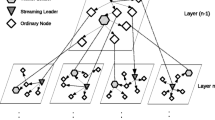Abstract
To model a layered video streaming system in super-peer overlay networks that faces with heterogeneity and volatility of peers, we formulate a layer scheduling problem from understanding some constraints such as layer dependency, transmission rule, and bandwidth heterogeneity. To solve this problem, we propose a new layer scheduling algorithm using a real-coded messy genetic algorithm, providing a feasible solution with low complexity in decision. We also propose a peer-utility-based promotion algorithm that selects the most qualified neighbor to guarantee the sustained quality of streaming despite high intensity of churn. Simulation results show that the proposed layer scheduling scheme can achieve the most near-optimal solutions compared to the four conventional scheduling heuristics in the average streaming ratio. It also highly outperforms those with different peer selection strategies in terms of the average bandwidth (6.9 % higher at least) and the variation of utilization (11.3 % lower at least).











Similar content being viewed by others
Notes
Unlike the conventional video compression algorithms based on single-layer approaches, such as MPEG-4 and H.264/AVC, the scalable video is variable and flexible according to various network and device conditions. It can be dynamically retransformed in terms of spatial, temporal, and quality scalabilities.
References
Ibaraki T, Katoh N (1988) Resource allocation problems: algorithmic approaches. MIT Press, Cambridge
Stutzbach D, Rejaie R (2005) Understanding churn in peer-to-peer network. In: Proceedings of the ACM Internet measurement conference (ACM IMC)
Zhou X, Ge Y, Chen X, Jing Y, Sun W (2012) A distributed cache based reliable service execution and recovery approach in MANETs. J Converg 3(1):5–12
Pai V, Kumar K, Tamilmani K, Sambamurthy V, Mohr AE Mohr EE (2005) Chainsaw: eliminating trees from overlay multicast. In: Proceedings IEEE INFOCOM
Zhang X, Liut J, Lis B, Yum T-SP (2005) Coolstreaming/DONet: a data-driven overlay network for efficient live media streaming. In: Proceedings IEEE INFOCOM
Agarwal V, Rejaie R (2005) Adaptive multi-source streaming in heterogeneous peer-to-peer networks. In: Proceedings of the multimedia computing and networking (MMCN)
Zhang M, Chen C, Xiong Y, Zhang Q, Yang S (2007) Optimizing the throughput of data-driven based streaming in heterogeneous overlay network. In: Proceedings of ACM multimedia modeling (ACM MMM’07)
Xiao L, Zhuang Z, Liu Y (2005) Dynamic layer management in superpeer architectures. IEEE Trans Parallel Distrib Syst 16(1):1078–1091
Li J-S, Chao C-H (2010) An efficient superpeer overlay construction and broadcasting scheme based on perfect difference graph. IEEE Trans Parallel Distrib Syst 21(5):594–606
Kim H, Lee S, Lee J, Lee Y (2010) Reducing channel capacity for scalable video coding in a distributed network. ETRI J 32(6):863–870
Mastroianni C, Cozza P, Talia D, Kelley I, Taylor I (2009) A scalable super-peer approach for public scientific computation. Future Gener Comput Syst 25(3):213–223
Schwarz H, Marpe D, Wiegand T (2007) Overview of the scalable video coding extension of the H.264/AVC standard. IEEE Trans Circuits Syst Video Technol 17(9):1103–1120
Goldberg DE, Korb B, Deb K (1989) Messy genetic algorithms: motivation, analysis, and first results. Complex Syst 3:493–530
Wei Q, Qin T, Fujita S (2011) A two-level caching protocol for hierarchical peer-to-peer file sharing systems. J Converg 2(1):11–16
Luo H, Shyu M-L (2011) Quality of service provision in mobile multimedia—a survey. Hum-Cent Comput Inf Sci. doi:10.1186/2192-1962-1-5
Goldberg DE (1989) Genetic algorithms in search, optimization, and machine learning. Addison-Wesley, Reading
Moon Y-H, Youn C-H (2012) Integrated approach towards aggressive state-tracking migration for maximizing performance benefit in distributed computing. Clust Comput. doi:10.1007/s10586-011-0197-0
Lobo FG, Goldberg DE, Pelikan M (2000) Time complexity of genetic algorithms on exponentially scaled problems. In: Proceedings of the genetic and evolutionary computation conference, pp 151–158
Leonard D, Yao Z, Rai V, Loguinov D (2007) On lifetime-based node failure and stochastic resilience of decentralized peer-to-peer networks. IEEE/ACM Trans Netw 15(3):644–656
Ross SM (1996) Stochastic processes. Wiley, New York
Aikebaier A, Enokido T, Takizawa M (2011) Trustworthy group making algorithm in distributed systems. Hum-Cent Comput Inf Sci. doi:10.1186/2192-1962-1-6
Overlay and peer-to-peer network simulation (OverSim) framework. http://www.oversim.org/
Acknowledgements
This research was equally supported by R&D programs of MEST/NRF [2012-0020522, the Next-Generation Information Computing Development Program], and MKE/KEIT [10039260, Integrated development environment for personal, biz-customized open mobile cloud service and Collaboration tech for heterogeneous devices on server]. This research also was supported by IT R&D program of MKE/KEIT [10038768, The Development of Supercomputing System for the Genome Analysis].
Author information
Authors and Affiliations
Corresponding author
Rights and permissions
About this article
Cite this article
Moon, YH., Kim, JN. & Youn, CH. Churn-aware optimal layer scheduling scheme for scalable video distribution in super-peer overlay networks. J Supercomput 66, 700–720 (2013). https://doi.org/10.1007/s11227-012-0858-7
Published:
Issue Date:
DOI: https://doi.org/10.1007/s11227-012-0858-7




